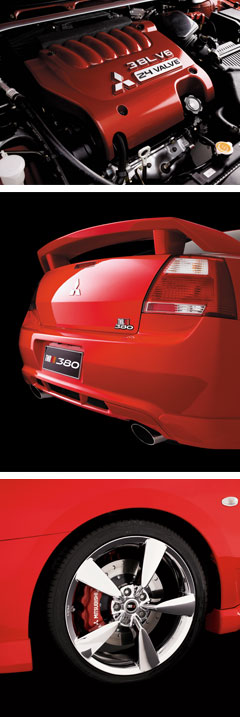Sydney show: Mitsu fires back with blown 380
BY NEIL MCDONALD AND TERRY MARTIN | 26th Oct 2006

Still fending off speculation this week that its manufacturing future in Australia is in doubt, and having been forced in recent months to contend with the arrival of the Toyota Aurion, Holden VE Commodore and Ford BFII Falcon, Mitsubishi returned the attention of the crowd at the Darling Harbour Exhibition Centre back to the 380.
Although described as a concept for now, the Team Mitsubishi Ralliart 380 looks set to become – at the very least – a low-volume production model that would become the new torchbearer for Mitsubishi's struggling Australian-built car.
For more than six months the TMR 380 was buried in the Melbourne skunk works at Team Mitsubishi Ralliart, where the project group led by former V8 guru Alan Heaphy took the VR-X-based variant to new heights. And the result is stunning.
Combining a Sprintex supercharger to the 3.8-litre V6 has increased power to 230kW at 5250rpm and torque to an arm-wrenching 442Nm at 4000rpm, slashing the 0-100km/h acceleration benchmark for the sedan to a mere 6.0 seconds. The quarter mile is consumed in just 14.0 seconds.
This might not be the stuff that suits an Evo badge. But Ralliart? You bet.
"If you look at the brand strata, the Evolution is the pinnacle and at this stage there will probably only be Pajero and Lancer as Evolution models," Mitsubishi Australia spokesman Kevin Taylor told GoAuto.
"But underneath that you'll have a performance range, branded Ralliart, which will be required to give significant performance improvements in engine, handling and braking to be able to wear the Ralliart badge.
"Looking at the specs for the TRM 380 I would say it meets all those criteria." Mr Taylor said a low-volume run would be simple enough to integrate into the production line given the 380's low build rate in Adelaide.
"In the case of the TMR, some of it may be production line and some of it would be off-line but the lower line speed and flexibility in the plant means we are able to do more than what some other people may be able too," he said.
Most importantly, its role as a much-needed Aussie-built hero car for Mitsubishi cannot be underestimated.
"The majority of people who buy a car will want to be associated with a brand that's exciting and aspirational," Mr Taylor said. "So cars like the TMR are halo cars for the product line but also for the overall brand. They help make Mitsubishi exciting as a brand and make people want to put Mitsubishi on their shopping lists."

Enhancing the ride and handling are Koni 8211 series coil-overs dampers, with adjustable bump and rebound settings, and 65mm diameter springs with beefier front and rear spring rates. Adjustable spring seats allow for the vehicle to be set at the correct corner weights and ride height, the latter being 50mm lower than the production car.
The same front brake package is adopted as used on the TMR 220 Evo. Unique six-piston TMR-developed front callipers clamp 2550 Ferodo performance brake pads on to larger and thicker brake rotors which measure 343mm x 32mm. Rear brakes comprise Brembo four-piston callipers working with 302mm x 18mm ventilated one-piece rotors.
The car is shod with 19-inch Goodyear Eagle F1 GS-D3, 235/40R19 tyres and five-spoke chrome-finished ROH alloy wheels.
Other exterior enhancements include the addition of a full body kit that has side skirts, upper and lower grilles and twin bonnet scoops.
The new rear bumper has been styled to suite the dual exhaust system while the rear spoiler has increased in size for more downforce at speed. TMR sport-spec rear-vision mirrors have been lifted from the Lancer Evolution racecars.
The car is painted in Mitsubishi Motor Sports rally team red – Ralliart Red – with Stealth Black grilles.
Inside, a theme of "black ice" is complemented with carbon fibre look around the gearshift. Body-hugging electric Recaro front seats from the Evo-IX, re-trimmed with red leather flashes. The rear seats have also been re-trimmed to match the Recaros, while the cushions have been re-bolstered to provide the support of the front sports seats.
The centrepiece of the in-car entrainment is an Eclipse AVN6000 multi-media system. It features a DVD based navigation system with 6.5-inch wide TFT screen, dual-DVD multi source receiver, DVD-video, DVD-R/RW, CD, CD-R/RW, CD changer control, MP3, WMA and, just to add a couple more acronyms, AM/FM. The AVN6000 also features a rear-reversing camera.
As well as the TMR 380, Alan Heaphy's crew has given the Lancer Evo IX a makeover, changing the exhaust, boost curve and optimising the engine management system to give more power. Cosmetic enhancements also give the Evo IX a more aggressive look.
Also unveiled in Sydney this morning was the new Outlander and Pajero SUVs, the Colt Ralliart and Cabrio and Dakar rally car direct from Paris.